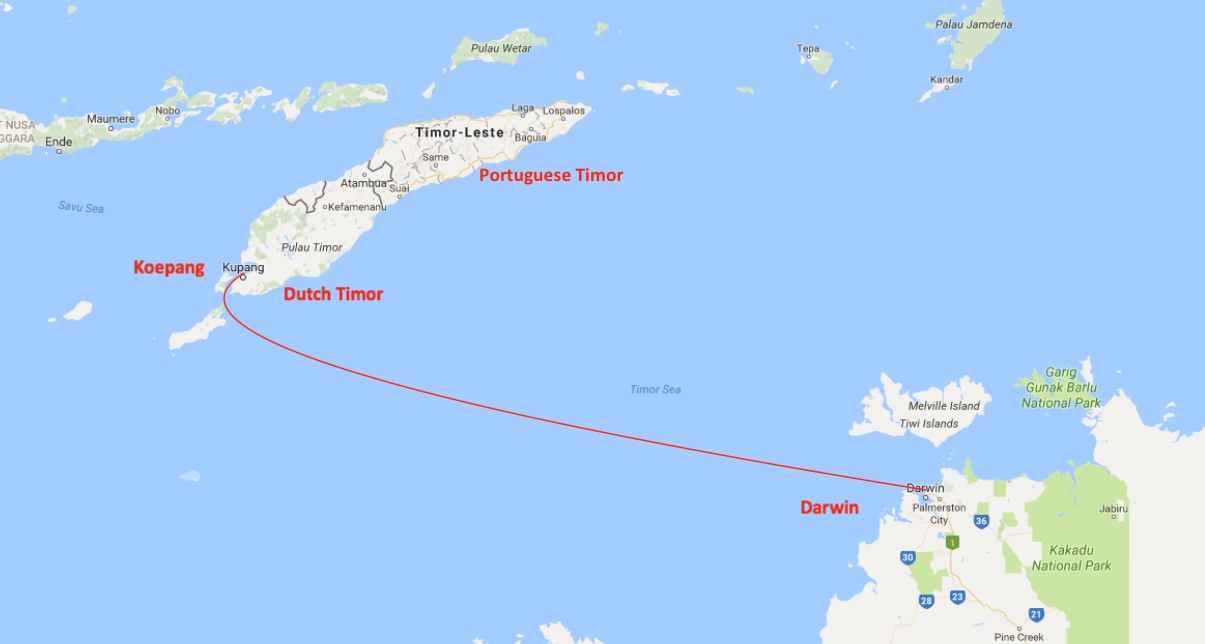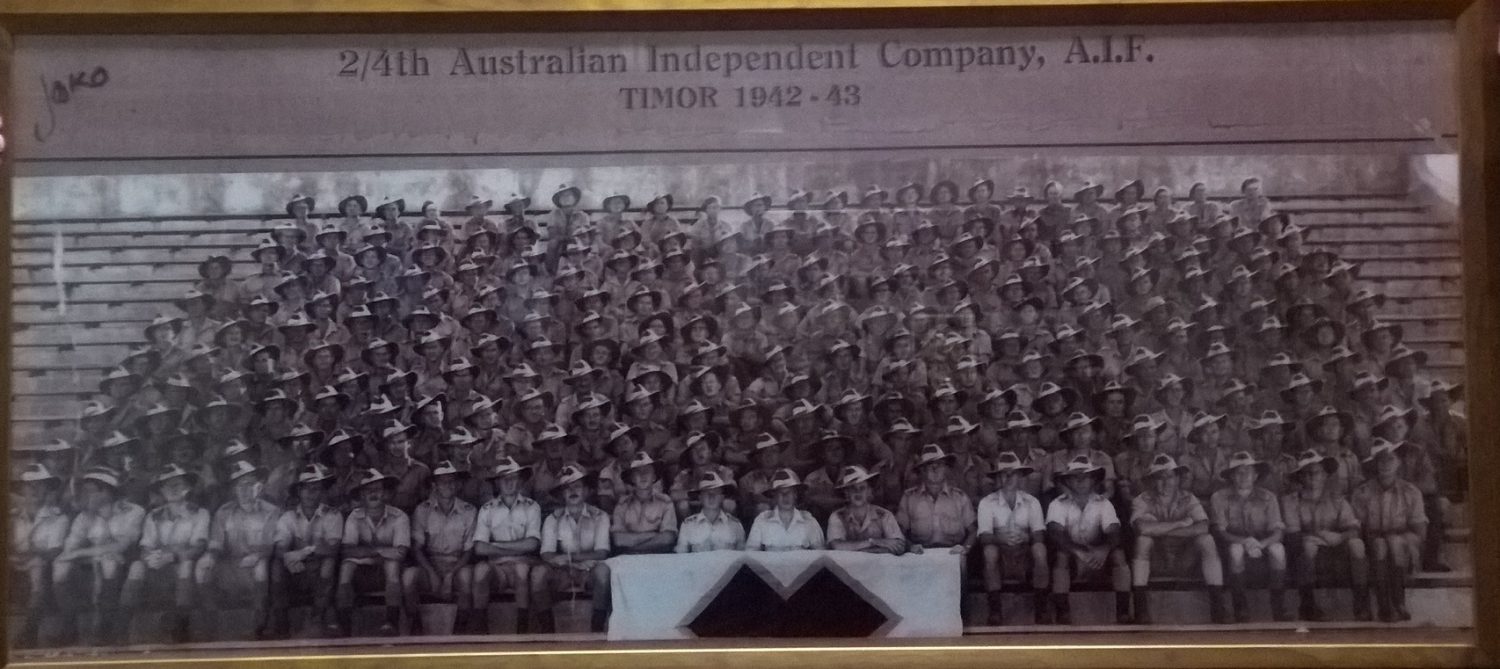Sparrow Force was one of three formations rapidly put together by the Australian Government in March and April of 1941 when concern was rising about the intentions of the Japanese to enter WW2 as a combatant and to form a ring of defenses against any advance on Australia. The three forces were given code names of birds: Gull, Lark and Sparrow. Gull and Sparrow were formed at the request of the Dutch government.
Gull Force was sent to Ambon and was soon overcome. The survivors were then mainly executed.
Lark Force went to Rabaul on the north tip of the island of New Britain. It too was soon overwhelmed by a far superior Japanese force and the vast majority were captured with a majority of those executed or used for bayonet practice by Japanese troops and beheading practice for junior Japanese officers. The massacres at Tol Plantation have been mentioned in other articles.
Sparrow Force was by far the largest of the three. It was predominantly comprised of two Australian units; the 2/40 Battalion of the 8th Division raised in Tasmania and the 2/2 Independent Company raised in WA plus a battery of coastal artillery, anti-aircraft gunners, engineers and signallers, about 2,000 troops in all. Included were elements of British, Dutch, and American personnel as the concept had originally been sanctioned by the ABDA organisation which was subsequently abandoned.
[The American-British-Dutch-Australian (ABDA) Command, or ABDACOM, was a short-lived, supreme command for all Allied forces in South East Asia in early 1942, during the Pacific War in World War II.]

'Sparrow Force' - Timor 1942, (Image: NAA)
Sparrow Force members who were captured by the Japanese did not suffer the same fate as those from Gull and Lark Forces. They were removed to prison camps throughout Asia and many died in captivity. Further, they were not overwhelmed by the large Japanese forces sent to attack them. They prevailed against great odds and although they were evacuated in the end it could not be said that they had been defeated. Far from it. The evacuated troops went on to serve in other areas against the Japanese.
Sparrow Force was sent to Timor in December, 1941 after have undergone training in Darwin. Timor was divided between the Dutch owned territory in the west and Portuguese in the east. Portugal was a neutral country throughout WW2. The Portuguese government had not been consulted to allow allied troops to occupy any part of it. Koepang on the western end of Timor was a critical refuelling post for aircraft heading to Java and the Philippines because they did not have the range to get from Darwin in one hop.

The 2/40 battalion were dispatched to Koepang. The 2/2 Independent Company, commandos, went to Portuguese Timor but were confined to the beaches due to diplomatic procedures.
The Japanese attack on Darwin was linked to their landings on Timor on 19th February, 1942. The attack on the Koepang area began with landings by Japanese marines followed by paratroopers the following morning. The 2/40 were overwhelmed by sheer numbers of well supplied Japanese troops which, at that stage, numbered about 22,000. They held out until the 23rd of February when it was agreed by headquarters after consultation with the troops that their position was hopeless and surrender was the best option. In three days of fighting the Australians had lost 84 killed and 132 wounded. Those taken into captivity were transferred to POW camps and disbursed from there to work as slave labour for the Japanese. Many died in captivity but there was no wholesale slaughter as happened at Ambon and Rabaul.
The 2/2 Independent Company based around Dili in the east had a much different experience. While the Japanese landed at Koepang virtually unopposed, the invasion force at Dili, which had been supported by a barrage from two battleships, met very strong resistance and suffered heavy casualties. Eventually, realising that they were heavily outnumbered the commandos took to the hills around Dili and from there carried on a guerrilla war with the help of the local people.
The commandos had been trained by a British officer whose orders were “To stay behind, live off the country or be provisioned by air and be a thorn in the side of the occupying enemy, emerging in true guerrilla style to attack vital points and then disappear again into the jungle.”
The commandos did this job very well. For 7 months they harassed the Japanese killing about 1,500 of them and losing only 40 of their own. This might not sound much of a contribution to the total picture but in doing what they did the commandos tied up more than an entire division in Timor which could otherwise have been used in their campaigns in New Guinea. The main enemy of the commandos was not the Japanese but malaria, a disease for which they were much unprepared.
The organisational structure of the commandos was different to a front line infantry battalion in that they were a self-contained unit having their own engineers and signallers although they did lack heavy weapons and transport. Mobility was provided by the Timor mountain ponies, the famous little beats that figure in The Man from Snowy River, “… with a touch of Timor pony, three parts thoroughbred at least…”.
PORTUGUESE TIMOR. 1942. HORSES (TIMOR PONIES) BEING LOADED WITH GEAR, PART OF A PACK TRAIN USED BY MEMBERS OF THE 2/2ND INDEPENDENT COMPANY
Following the surrender by the 2/40 it was assumed that the 2/2 had also been lost and were out of contact with Australia. The actions undertaken by them were unknown to Australian headquarters for several months. The commandos truly did live off the land eating wild pigs, crocodiles and buffalos plus whatever could be provided by the local people or stolen from Japanese camps in hit and run raids.
Although officially and notionally neutral, the local people were sympathetic and supportive of the commandos providing intelligence, guides, carriers and communications. The local telephone system was able to be used for internal communication but not for overseas contact.
As a neutral country, Australia still had a diplomatic representative on Timor, David Ross who was also the Qantas agent, and through him the Japanese commander sent a message to Lt. Colonel Spence, commander of the 2/2 demanding that they surrender. Spence replied “Surrender? Surrender be fucked.”
In April, following a series of raids on Japanese posts, the commandos had accumulated a generator and a collection of spare radio parts of all descriptions. Specialised electrical engineers within their group eventually were able to able to assemble and make a radio which they got working and made contact with Darwin. At Darwin, there was much speculation that the contact was genuine and not Japanese spies impersonating Australians. The belief was that the 2/2 had been annihilated but after answering some very specific personal questions Darwin was convinced that the contact was indeed genuine. Soon after, airdrops were made followed by supply and evacuations by sea.
In May the Japanese high command despatched a highly regarded veteran of the Malaya campaign, known as The Tiger of Singapore, to Timor to bring the resistance of the commandos and local forces to an end. On 22nd May, the Tiger, riding a white horse lead a Japanese force in pursuit of the Australians. The Australians ambushed the Japanese killing 5 of them then they made a second ambush during which the Tiger was killed along with 24 more Japanese soldiers. The force retreated to Deli.
In June the relationship between the Japanese and Portuguese officialdom had deteriorated to the point where the Japanese cut off the diplomatic telegraph link to Lisbon and complained that the Governor was not punishing Portuguese officials who were helping the Australians in breach of their neutral status. No action was taken by Lisbon. The Japanese commander sent another demand to surrender via David Ross but this time there was no response. David Ross was then evacuated by Catalina flying boat on 16th July.
In August, the Japanese began garrisoning towns in East Timor with a plan to outnumber the Australians by 100 to 1. They then launched a major offensive designed to push the Australians into a corner on the south coast and at the same time attacked a Dutch position which was holding out in the centre of the island.
On 19th August a large proportion of the Japanese force was withdrawn to Rabaul. They were short of troops in other theatres. At the same time, a town 70 miles from Dili rebelled against the Portuguese administration causing some local people to be recruited by the Japanese.
In September, the Japanese again reinforced their garrison troops and the Australians were reinforced by 450 commandos from the 2/4th Independent Company, known as Lancer Force.

In October the Japanese had recruited large numbers of Timorese civilians who suffered heavy casualties being used in frontal assaults against the allies. They also took action against Portuguese civilians who were now confined to a “neutral zone”. This only encouraged more defiance in support of the Australians who responded by issuing weapons to Portuguese officials and evacuated 300 women and children in RAN supply ships.
In November Lt.Colonel Spence was replaced as Allied Commander on Timor. The corvette HMAS Armidale was sunk while attempting to land Dutch reinforcements. The Australian government sent the renowned documentary film maker, Damien Parer to Timor where he made the film Men of Timor.
By the end of 1942 the chances of the allies retaking Timor were remote. The Japanese now had 12,000 troops permanently garrisoned on the island, the position of the commandos was becoming untenable and the demands for supply and support in other areas of Australian operations prevented continuation on Timor being sustained. On the nights of 15-17 December the remnants of Sparrow Force were evacuated. Lancer force was evacuated on the night of 9/10 January,1943 along with 50 Portuguese civilians on HMAS Arunta. A small remaining intelligence force was left behind but after discovery by the Japanese were evacuated by the US submarine Gudgeonon 10th February.
HMAS Arunta
Following the evacuation the 2/2 Independent Company was renamed 2/2 Commando Squadron and fought in New Guinea and New Britain finishing the war in Rabaul.
For their support of the Australians who remained on Timor after the surrender of the 2/40 battalion, the Timorese people suffered somewhere between 40,000 and 70,000 killed in either action or as reprisals for assisting the Australian commandos. They were unstinting in their loyalty until the Japanese pressure rose to the point in October, 1942 where they had little choice. Although the resistance of the forces on Timor had little strategic value in the whole of the allied plan, the fact that so many Japanese troops and resources were tied up opposing them justified the efforts of these resourceful and brave Australians.
In rising to the defence of the East Timorese to resist the incursions of the Indonesian Army, Major General Cosgrove, as leader of the INTERFET Force in 1999 repaid, in part, the debt that our country owed to these people in our darkest days.
BLOG COMMENTS POWERED BY DISQUS






























































